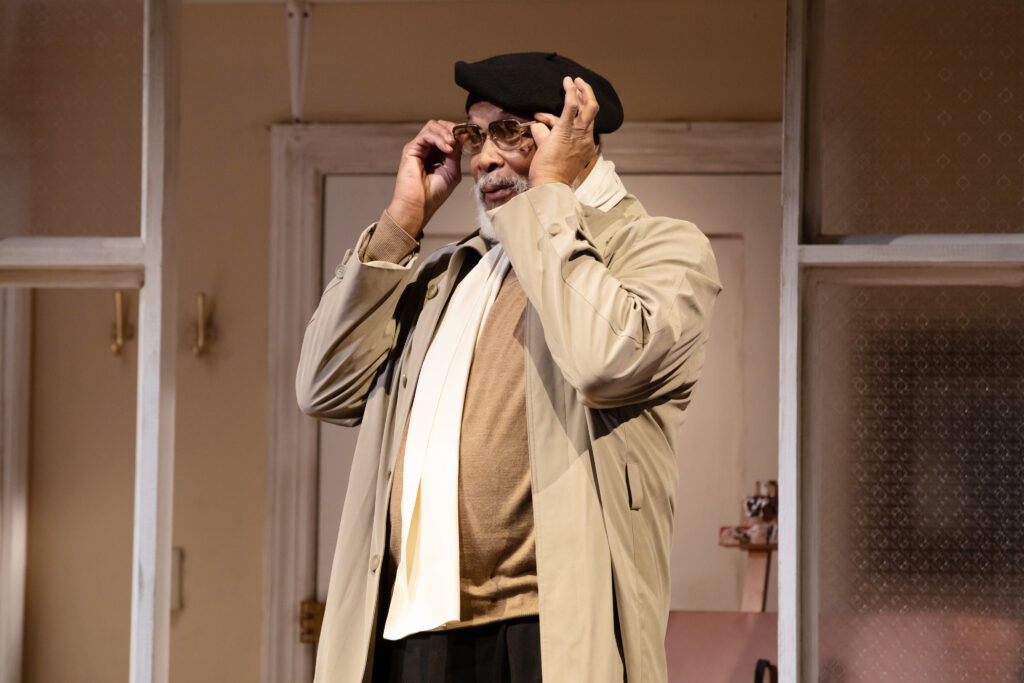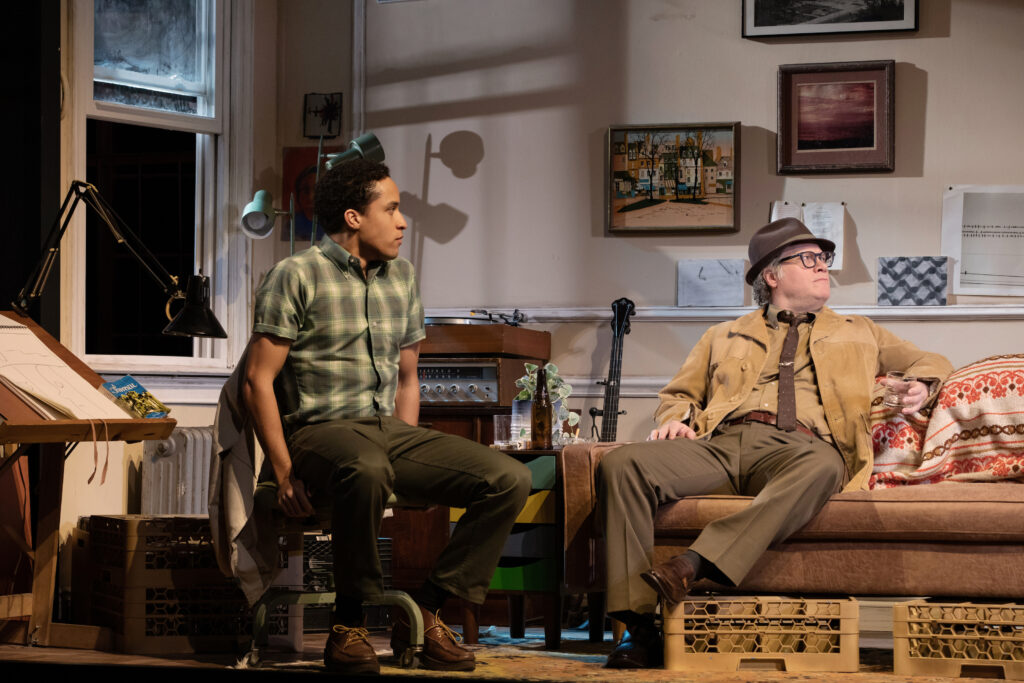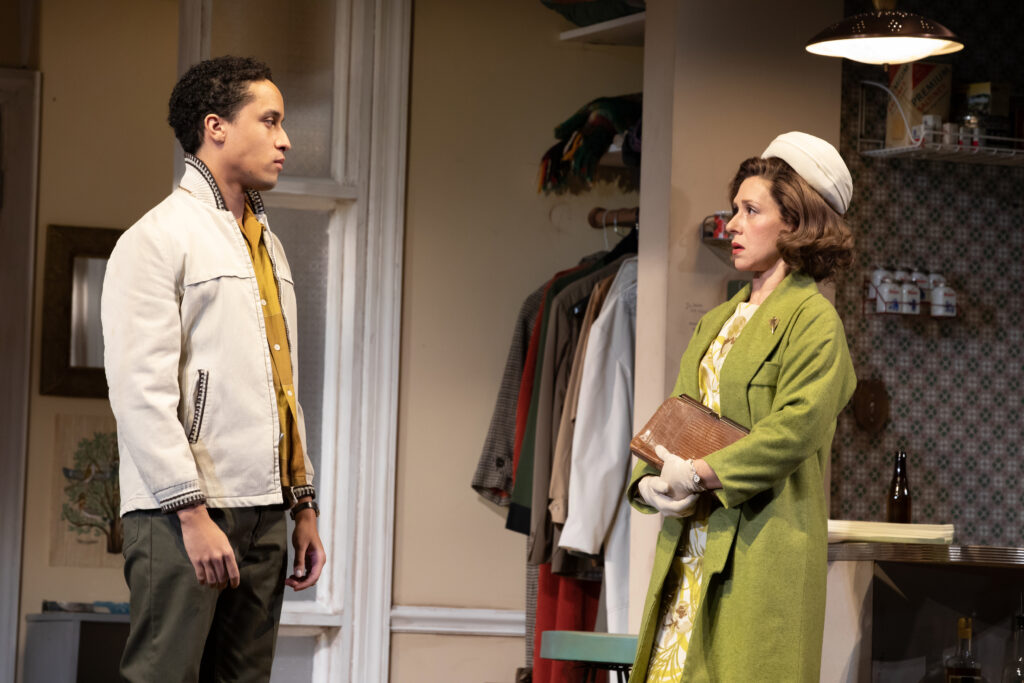By Carol Rocamora . . .
Why did it take so long?!
That’s what I kept thinking, watching the thrilling revival of Lorraine Hansberry’s The Sign in Sidney Brustein’s Window that just opened at the Brooklyn Academy of Music. Catapulted into theater oblivion after it opened on Broadway to dismissive reviews in 1964, the play lay largely dormant for over 50 years, until director Anne Kauffman resurrected it in a revelatory revival at the Goodman Theatre in 2016. “A masterpiece lost in plain sight,” declared the Chicago Tribune about this powerful work by an American playwright who, until now, was known almost exclusively for A Raisin in the Sun. And now, thanks to Kaufman and BAM, it’s seeing the light again—and what a bright light it is! We all thought Hansberry was a “one-play writer,” and were we ever wrong.

Set in the 1960s in Greenwich Village, The Sign in Sidney Brustein’s Window is what we call A Big Play—of the magnitude of American classics by Miller, Williams, and Albee, with a robust traditional dramaturgy, richly developed characters, and profound themes. According to the program notes, it’s based on Hansberry’s “family” of friends (she once lived in the Village with her husband Robert Nemiroff), and features a colorful coterie of characters, cameos of that time and place. Central to the story are Sid (Oscar Isaac) and Iris (Rachel Brosnahan), a young couple struggling to survive in their marriage and in the world. Sid, the idealist, is unrealistic in his aspirations. He’s just failed as founder of the ill-conceived, ill-fated Walden Pond (meant to be a poetry/folk music hangout, not the night club it became). He’s now an arts-newspaper owner (The New Village Crier) which he’s home-publishing in their cramped Village apartment. Iris, a part-time waitress, is determined to realize her dream of being an actress/dancer. Frustrated by endless auditions, she lacks confidence—no thanks to Sid, who is constantly putting her down.
Their apartment is a magnet to an assortment of Village types (“bohemians,” in Hansberry’s words). There’s Max (Raphael Nash Thompson), the Black anti-establishment artist whom Sid commissions to design his newspaper’s front page (it’s indecipherable). There’s David (Glenn Fitzgerald), the gay dramatist upstairs who has written a play featuring two men in a refrigerator (theater of the absurd was the rage in the sixties). There’s Alton (Julian De Niro), a Black bookstore employee who falls in love with Iris’s younger (white) sister Gloria. And there’s Wally (Andy Grotelueschen), a reform candidate up for election whom they all support. Sid has hung a campaign banner in his window—“Wipe Out Bossism: Vote O’Hara for Reform!” (Hence, the play’s title).


As for Iris’s sisters, the older Mavis (Miriam Silverman) is a paragon of prejudice—she’s anti-Semitic, anti-Black, anti-gay, and constantly trying to coax her younger sister Iris to conform. Mavis is a sharp contrast to their youngest sister, Gloria (Gus Birney), an “escort” (i.e. call girl) who drowns her identity in drink and drugs.
The Sign in Sidney Brustein’s Window itself is a multifaceted sign of the times. It simmers to the boiling point with issues: bohemianism (as Hansberry calls it), social reform, racism, anti-Semitism, gay prejudice, drugs, and feminism. It’s also overflowing with ideas—about psychotherapy (Iris is in analysis, and is always scrutinizing Sid); about corrupt politics (it turns out that Wally, the so-called reformer, is “owned” by the establishment); about liberalism; about Black awareness; and, above all, about identity. It’s a rich portrait of the 1960s, an iconic era about which we speak so frequently and now have an enhanced understanding, thanks to rediscovering this treasure of a play written with such fierce intelligence, eloquence, and unexpected humor.


Kauffman’s large-scale production fills the cavernous Harvey Theater with life. The impressive scenic design (by “dots”) features a cozy, cramped New York flat framed by fire escapes and a second floor-balcony (where David, Sid’s upstairs neighbor, can be seen). This larger framing device mirrors the play itself—a birds’ eye view of assorted Villagers in the larger context of a turbulent time. “The world is about to crack down the middle,” declares Sid. “We have to change, or else we’ll all fall into the crack.”
This stellar cast shines. Oscar Isaac is a marvel as the complex, contradictory character of Sidney (who knew that this versatile actor could also play the banjo!?), and it’s no surprise that Rachel Brosnahan is utterly captivating. When they are not sparring, their happy moments together are enchanting. Their duet in Act II is pure joy, as she dances (charmingly) to his impressive accompaniment. They’re a star-power duet, performing together with grace, agility and spontaneity.
Thanks to Hansberry’s craft, each character has a memorable moment. The bigoted Mavis of Act I (played by the marvelous Miriam Silverman) has an unexpected scene with Sid in Act II that reveals a strong inner self, given what she’s had to face in her own marriage. “There are two kinds of loneliness—with a man and without one,“ she declares (perhaps echoing the author’s own experience). Alton (the affecting Julian Nero) reveals the toll that racism has taken on his entire family, causing him to confront his own identity (as a light-skinned Black man) in a new light. David (a delightful Glenn Fitzgerald) experiences sudden success (his play is an unexpected hit) and challenges Sid to confront his inconsistencies.


Ultimately, this is a play about self-realization, tolerance, and acceptance of one’s self and others. The seemingly progressive Wally (an enthusiastic Andy Grotelueschen) turns out to be a turncoat, controlled by a political machine. But, as he explains to the idealistic Sid, that’s the only way change happens. “You can’t expect people to change,” counters Mavis. But they do change in this play—Hansberry intends it—especially Sid and Iris, as they face realities, modify their dreams, and find renewed appreciation and need for one another.
What shines above all is this gem of a forgotten play and the loving care that Anne Kauffman and her cast have given it. Thanks to this superb production, the play will claim its rightful place in the canon of great American drama of the twentieth century.
Hansberry died tragically at age 34, soon after the opening of The Sign of Sidney Brustein’s Window. Having rediscovered this play, we can only imagine what else she would have written, if only she had lived longer . . .
The Sign in Sidney Brustein’s Window. Through March 24 at the Brooklyn Academy of Music’s Harvey Theater (651 Fulton Street, at Ashland Place, Downtown Brooklyn). www.bam.org
Photos: Julieta Cervantes
Featured Image: Rachel Brosnahan, Oscar Isaac


















